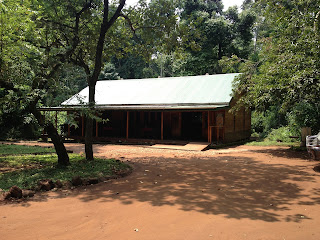
Safari…CHECK!!
A
whirlwind three days.
A 6:30am departure
Friday and a drive northwest out of Kampala provided us with a glimpse of Uganda
waking up.
Shops along the roadside
opening their doors.
Traffic
building.
Children walking to school. In
fact, everyone seems to either be walking, in a matatu (taxi van) or on a
bota-bota (motorcycle taxi). In the country, we find farms, markets, and
traditional homes along our journey.
A
traditional lunch at a roadside restaurant- posho (left, grits Ugandan style), matoke
(middle, boiled mashed banana) and ground peanut sauce (right).
 |
| Chimp nest in the trees |
Another two hours of driving brought us to the Bodongo Forest that is the home of a community of
chimps habituated to humans. Sauda, our
guide, took us on what was supposed to be a three hour hike through the trails of the forest in
search of chimps…looking for any sign of their presence…on the ground, up in
the trees, vocalizations. Despite
Sauda’s best attempts and an extra hour of hiking (4 total), no chimps:( While others
would have been disappointed, Mr. A and I were thrilled by the endless
walk…Mahogany trees, vines, thousands of butterflies, black and white colobus
monkeys, red tailed monkeys, dung beetles and yes…I grabbed a handful of sand
while crossing a creek for my sand collection.
The next morning, we left before 5am to drive to the ferry
that brought us across the Nile River to our game drive at sunset in Murchison National Park. As the morning mist burned off, animals just
appeared roadside…elephants, giraffes, every kind of antelope, hippos, birds,
birds and more birds. The feeling of
riding through the savanna standing up through the pop-up roof of our van is
indescribable. No lions…they were hiding
in the grass, but the fact I was mere yards from wild elephants, etc easily
made up for it.
In the afternoon, we went on a Nile cruise in small 16 seat
boat passing dozens and dozens of hippos, a few bachelor males African buffalo hanging
out in the water and Nile crocodiles…one so perfectly sunning itself on a
large rock that I thought I was back on the Jungle Ride in Disney World. As we approached Murchison Falls, the roar of
the Falls and the floating rafts of foam gave us a clue to the enormous energy
here. Then we started to approach the
rocks on the side of the river where a guide, Patricia, was standing, “This is
where you get off.” We knew there was a
hike involved but I had some image of a Niagara Falls-like “hike” along a trail
with a railing…all ADA compliant.
Instead, once we get on land, we are told “Go ahead and get a head
start. I will catch up with the next
group.” So off we went. Mr. A and me hiking all alone through the
African savanna on what I’ll conceded was a pretty decent trail (there were a
few railings and steps here and there).
While the majority of the dangerous animals were on the OTHER side of
the Nile and people hike this trail ALL day, it felt daring and very
adventurous. To finally emerge on at the
top of the Falls was a real victory!
With night coming, clouds forming and lightening in the
distance, we headed back to Bodongo for another night in their cabins.
During dinner, we finally heard chimps.
Their howls and hoots piercing through the
dark forest and joined by the other noises…cicadas, the human-like screams of
the hyrax, monkeys, etc.
 |
| Obama: mother from an American zoo & father from Kenya |
RHINOS: This morning,
we departed from Murchison and headed to Ziwa and the Rhino
Sanctuary.
Again, my prior
American experiences left me clueless about what to expect.
I thought the only rhinos in Uganda would be
behind a fence that we would walk up to.
Instead our guide was told the continuously tracked rhinos were in the
swamp…so we put on boots, drove to the swamp and hiked for a few minutes…and
then right in front of us were rhinos.
No fence…just me, Mr A, a guide, and about 100 feet from eight
rhinos!
We had been instructed to stay
close to the guide who kept us near trees we could hide behind or climb up in
case one charges us.
Instead, they
peacefully chomped on grass and a few males were play-fighting.
One is named Obama: his mother is a rhino
from an American zoo and his father was brought from Kenya as part of this
reintroduction program.
We moved around
the rare group of 8 (most people see 2 or 3) for about 30 minutes before
heading back.
This video gives you a sense of how close we were...it starts with me filming my boots and then panning up the the rhinos!!
 |
| Note Mr A's sleeve..we were that close! |
 |
| A rare herd of 8 rhinos....how many people have seen 8 in one place?? |
 |
| Me and my peeps! |
Overall, it has been a life-long dream to go on a
safari! Along the way, we found many
opportunities for future trips: places
to stay, how to get around, chimp trek, YES...do the Nile/Murchison hike,
volunteer and stay for several overnights working with the rangers at the rhino sanctuary, visit one of the rural
schools along the road to Murchison. Our
guide, Paul, was invaluable in giving us ideas, guidance and the low down on
everything Ugandan! With each day, the
idea of bringing students to Uganda seems more and more doable. Now that we have found ways to service
projects related to biodiversity and conservation, we will spend our remaining
two days exploring service and working with children at two different
orphanages around the city of Kampala.


























































